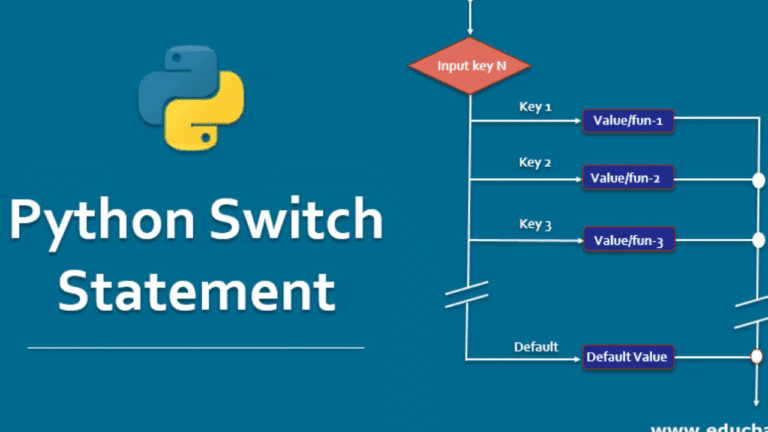Let’s be honest—if you’re coming from languages like C++, Java, or JavaScript, you’re probably wondering, “Where the heck is the python switch statemen?” It’s one of the first things people ask when transitioning to Python. So let’s clear things up and explore what Python offers instead.
Spoiler: It doesn’t have a traditional switch statement—but don’t worry. Python has its own clever tricks that get the job done (sometimes even better).
What Is a Switch Statement?
A Quick Look at Traditional Switch Statements
A python switch statemen lets you evaluate a single variable against a bunch of possible values, like so:
Why Developers Love Switch Cases
They’re clean, readable, and fast—especially when you have a long list of conditional checks. But here’s the thing…
Does Python Have a Switch Statement?
Spoiler Alert: Not Exactly
Python doesn’t have a built-in switch or case keyword like C or JavaScript. That’s right—there’s no native switch(x): in Python (at least, not until very recently).
The Philosophy Behind Python’s Simplicity
Python emphasizes readability and explicitness. Guido van Rossum (Python’s creator) believed that you could get the same behavior using other, more “Pythonic” ways—like if-elif-else or dictionaries.
Python Alternatives to Switch Statements
Let’s explore your options.
Using If-Elif-Else Blocks
This is the most straightforward method. It’s basically Python’s way of saying, “I don’t need switch—I’ve got this.”
Dictionary Mapping
A powerful and elegant approach. Think of it as a switch-case on steroids.
match-case (Structural Pattern Matching in Python 3.10+)
Starting with Python 3.10, we finally got something similar to a native python switch statemen. It’s called match-case, and it’s pretty darn cool.
Using If-Elif-Else Like a Switch Statement
Basic Syntax Example
Pros and Cons
-
✅ Simple and easy to understand
-
❌ Gets messy with too many conditions
-
❌ Not reusable like a dictionary or function map
Using Dictionaries as Switch Alternatives
Key-Function Mapping
Let’s say you have commands to process. A dictionary can map each command to a specific function.
Example with Functions as Values
Why This Method Is So Pythonic
-
It’s clean and readable
-
It scales easily
-
You can reuse functions across your code
-
It keeps logic out of giant if-else chains
Match-case: The Closest Thing to a Real Switch in Python
Introduced in Python 3.10
Finally! Python introduced structural pattern matching in version 3.10, bringing match-case to the table.
Syntax Overview
Example: Days of the Week
Matching Data Structures
match-case doesn’t just work with numbers or strings—you can match lists, tuples, dicts, and even custom objects.
Matching Lists
Matching Dictionaries
When to Use Each Approach
For Simple Choices: if-elif-else
Best when you have 3–4 simple comparisons.
For Scalable Logic: Dictionaries
Great when your logic maps cleanly to functions or actions.
For Complex Matching: match-case
Perfect for structured data, JSON parsing, or anything that requires pattern decomposition.
Why Python Avoided Traditional Switch Statements
Code Readability
Python’s style guide (PEP 8) leans toward simplicity. Nesting tons of case python switch statemen isn’t always the clearest choice.
Dynamic Typing Considerations
Python is dynamically typed. It doesn’t need rigid structures when flexible ones (like dictionaries and functions) will do.
Real-World Use Cases
Menu-Driven Programs
Perfect place for a dictionary of actions or a match-case block.
Event Handlers
Map event types to functions with a dictionary. Super clean and scalable.
Input-Based Logic
Collect user input and decide what to do with it based on a dictionary or pattern match.
Common Mistakes to Avoid
Forgetting Function Calls in Dictionaries
Not Checking Python Version for match-case
If you’re using Python < 3.10, match-case will throw an error. Always check your version!
Conclusion: The Pythonic Way to Switch
So, does Python have a switch statement? Technically no… but practically? Absolutely.
Whether you’re using if-elif-else, a dictionary of functions, or the new match-case syntax, Python gives you flexible tools to handle conditional logic in a way that feels natural and clean.
Forget rigid switch blocks. Think smart, think Pythonic.
FAQs
1. Is there a switch statement in Python 3?
Not in versions before 3.10. Starting from Python 3.10, match-case introduces switch-like behavior.
2. What is the best alternative to a switch in Python?
Dictionaries are the go-to choice for most cases. They’re clean, reusable, and efficient.
3. Can I use functions in a Python switch alternative?
Yes! You can map strings or values to functions using a dictionary for powerful behavior control.
4. What version introduced match-case in Python?match-case was introduced in Python 3.10.
5. Why did Python skip adding switch for so long?
Python emphasizes simplicity and readability. Other constructs like if blocks and dictionaries offer more flexibility without adding a new keyword.

